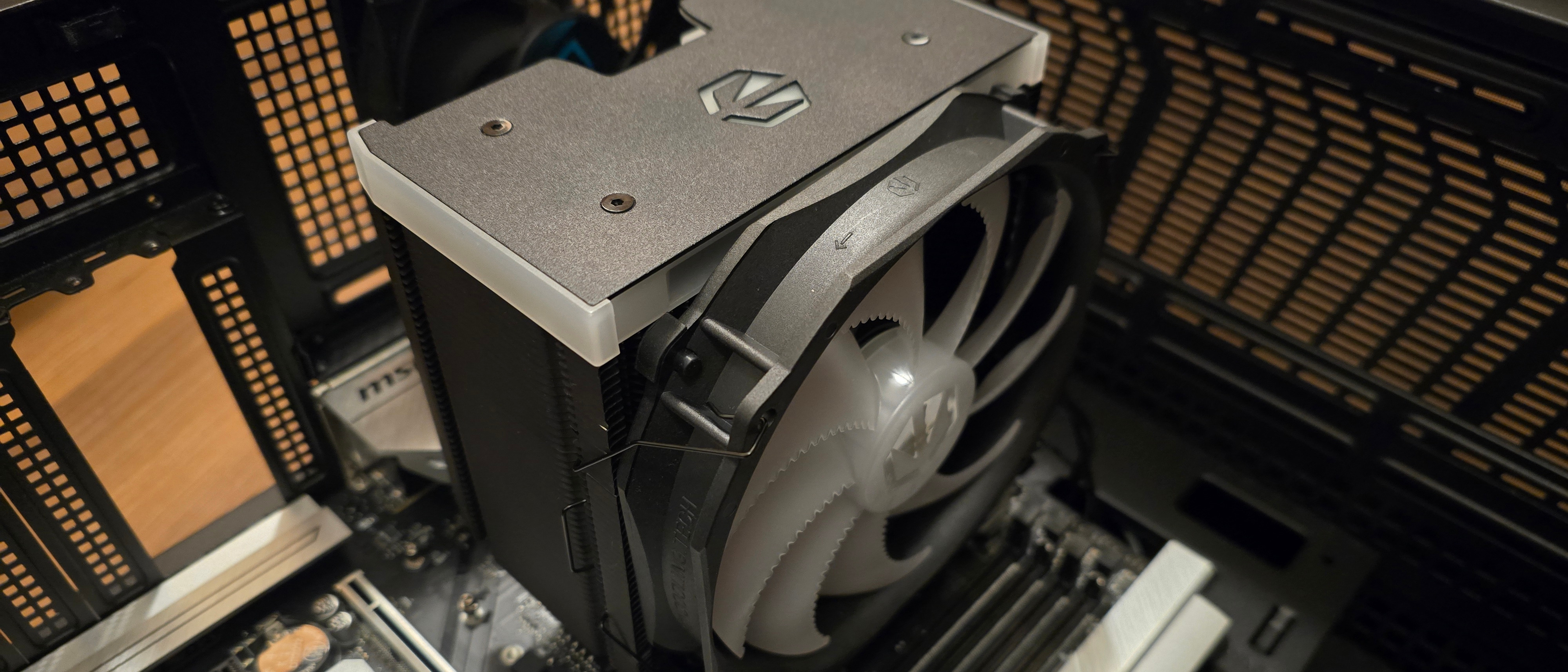Why you can trust Tom's Hardware
CPU-only thermal results without power limits
Because the CPU reaches its peak temperature (TJ Max) with air coolers like the one we’re looking at with this review, I’ve measured the CPU package power to determine the maximum wattage cooled to best compare their performance. This is why you won’t see results from the best AIO coolers in this chart.
It’s important to note that thermal performance can scale differently depending on the CPU it’s being tested with. First, we’ll look at results with Intel’s i7-14700K.
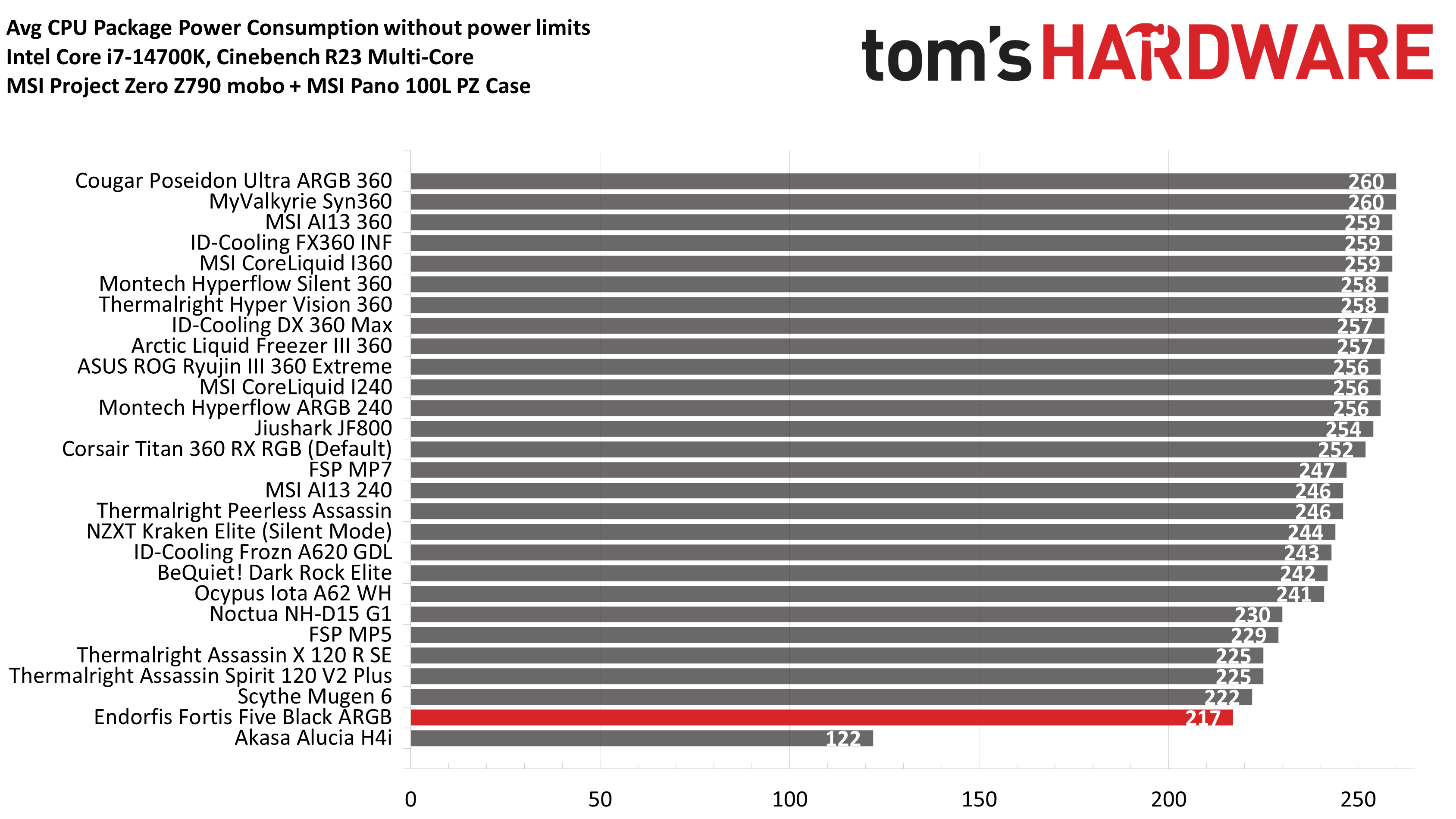
Looking at the results with Intel’s Raptor Lake CPU, you might think this cooler isn’t very impressive. It’s the worst-performing result I have in this chart, outside of a compact SFF cooler. Let’s take a look at how it handles AMD’s Ryzen 9 9950X3D now.
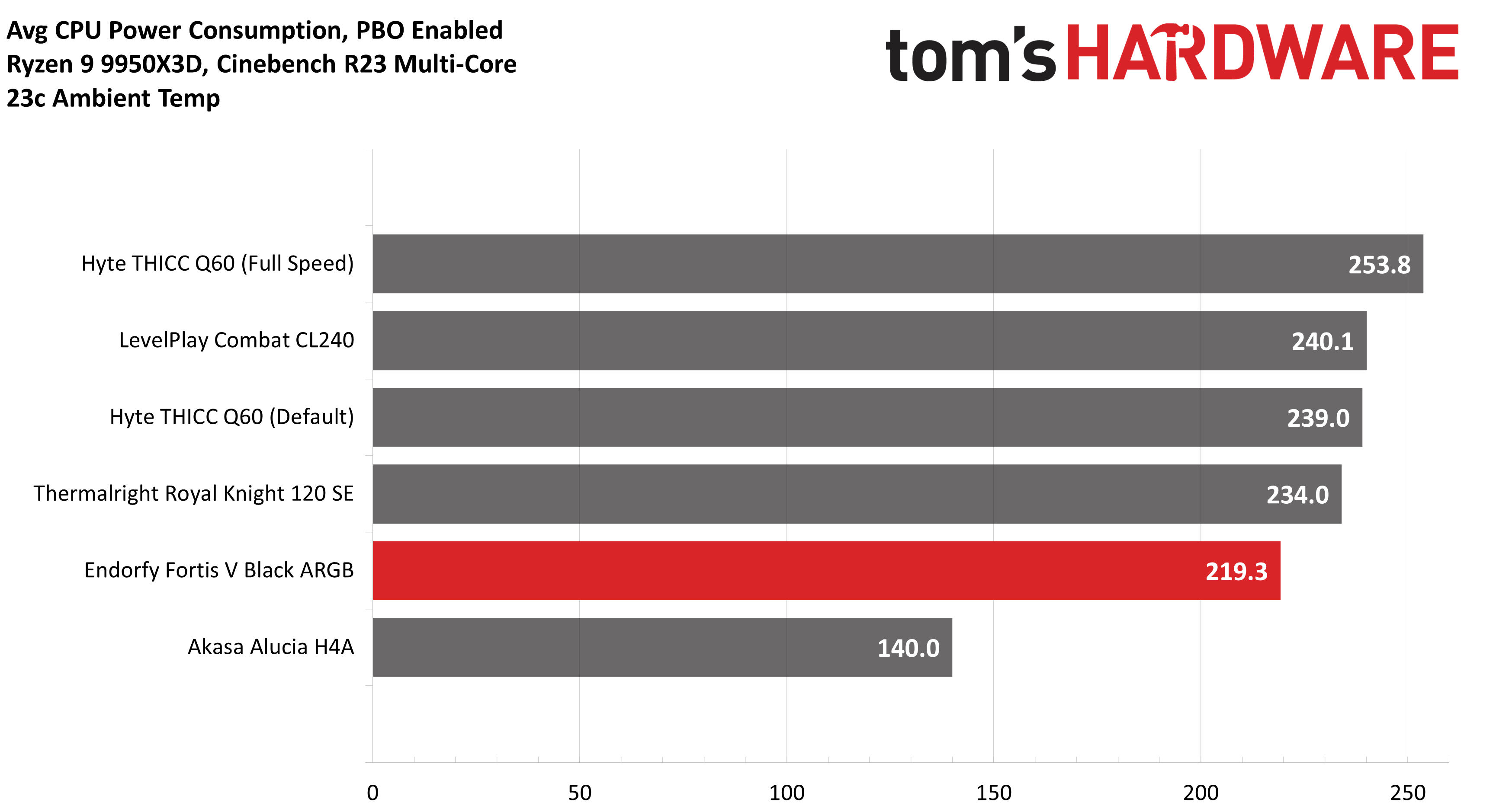
This is a much more impressive result. With 219W cooled on average, Endorfy’s Fortis 5 is able to handle the full “stock” power of AMD’s flagship CPU (~200W) and has a little bit of room to spare to let PBO push the CPU beyond its typical performance.
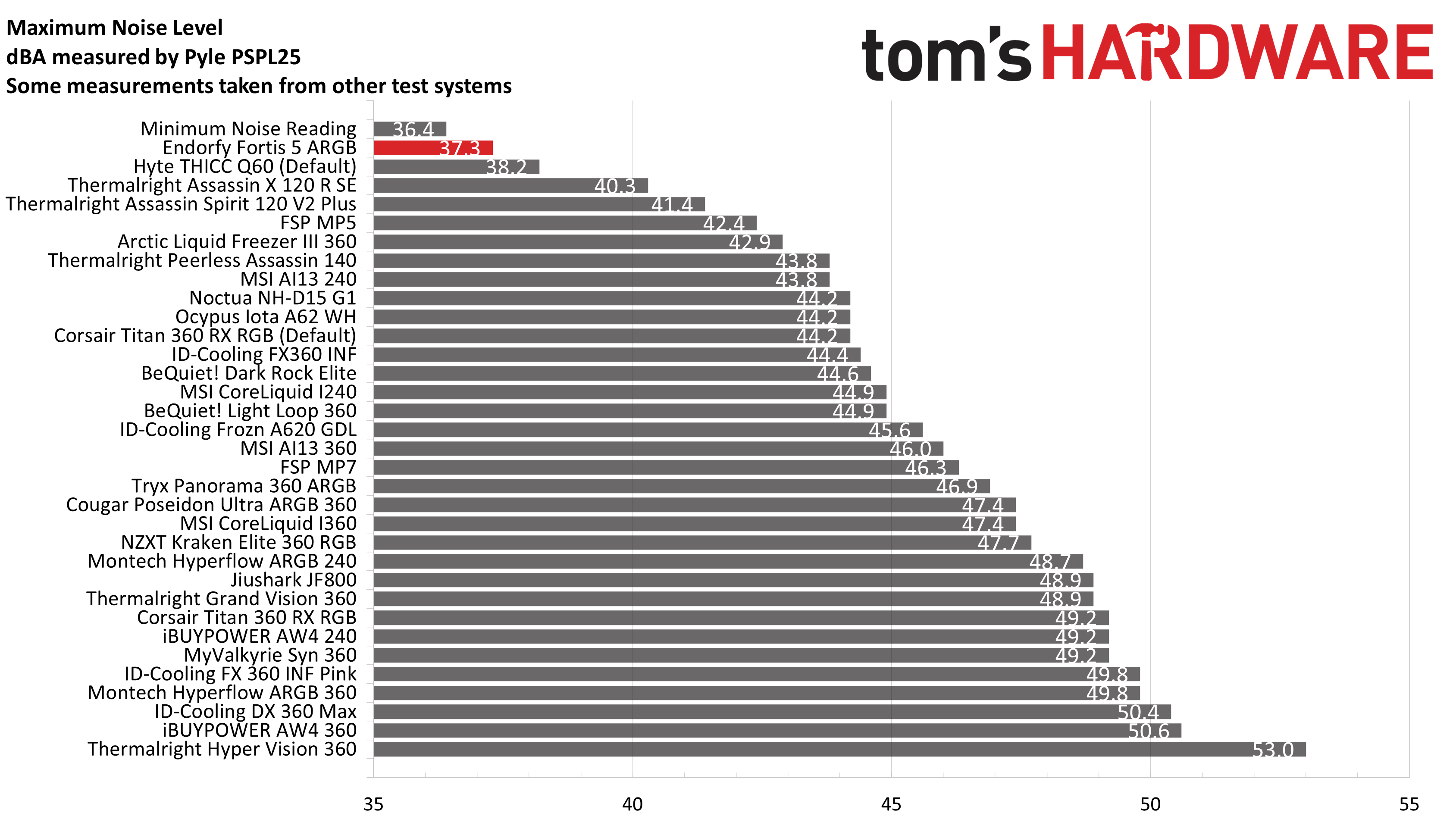
Noise levels are where this cooler shines. While thermal performance on Intel’s hottest CPUs isn’t the greatest, this cooler isn’t designed to win overclocking competitions. It’s designed to provide quietly running, essential cooling performance. With a maximum noise level of 37.3 dBA, this cooler is the quietest product I’ve tested on Intel’s Z790 Platform.
CPU-only noise normalized thermal results
Finding the right balance between fan noise levels and cooling performance is important. While running fans at full speed can improve cooling capacity to some extent, the benefits are limited and many users prefer a quieter system.
For noise-normalized testing with Intel CPUs, I typically set the noise levels of the cooler to reach 38.9 dBA. But this presents a problem: Endorfy’s Fortis 5 doesn’t reach that level of noise! Because this issue prevents a proper comparison to the other results I’ve collected, I’ll be skipping noise-normalized tests on Intel’s Core i7-14700K.
Let’s take a look at my initial noise-normalized results using AMD’s flagship Ryzen 9 9950X3D instead. This chart is still lacking the amount of comparison results I’d like, as I’ve just started sting with this CPU. That said, let’s take a look at what I have recorded thus far.
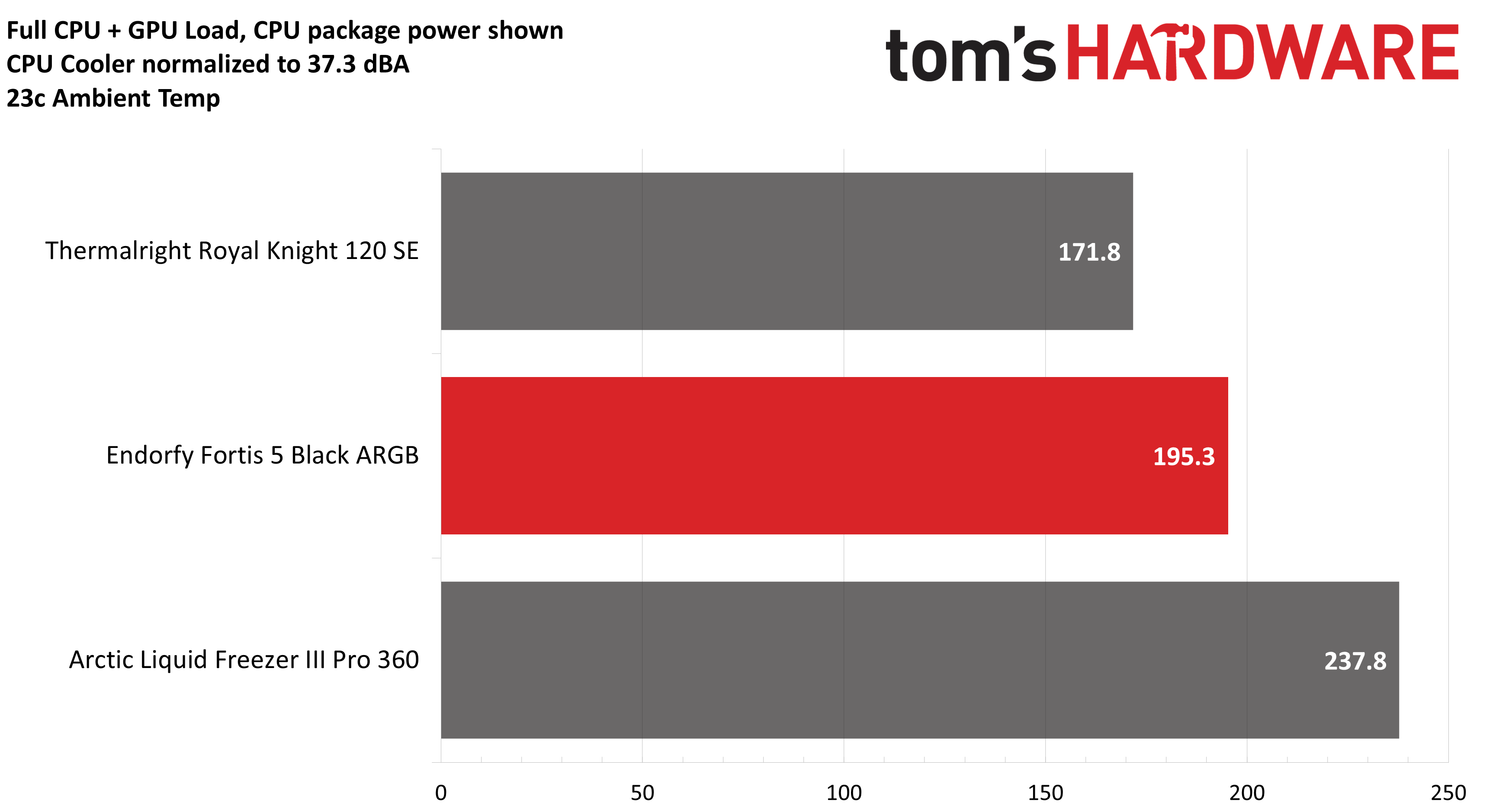
This test was run a little differently than I have done with previous tests on Intel CPUs. I’ve lowered the noise threshold of the CPU cooler down to 37.3 dBA, as some readers have indicated they consider 38.9 dBA “too loud” for this type of test. The other change is that I’ve measured the thermal performance of the cooler while also running Furmark 2 on MSI’s RTX 4070 TI Super, increasing the heat inside the case and increasing cooling difficulty.
The results here are encouraging. With 195W cooled, that’s almost the full power budget of AMD’s Ryzen 9 9950X3D at “stock” settings while the system also handles the full heat of a GPU. It performed significantly better than Thermalright’s impressive Royal Knight 120 SE in the same scenario!
“Stock” 200W results
My recent reviews have focused more on tests with both the CPU and GPU being stressed, but many have indicated they would like to see more CPU-only tests. So let’s take a look at how Endorfy’s Fortis 5 handles the Ryzen 9950X3D with default power levels, which limits consumption to ~200W.
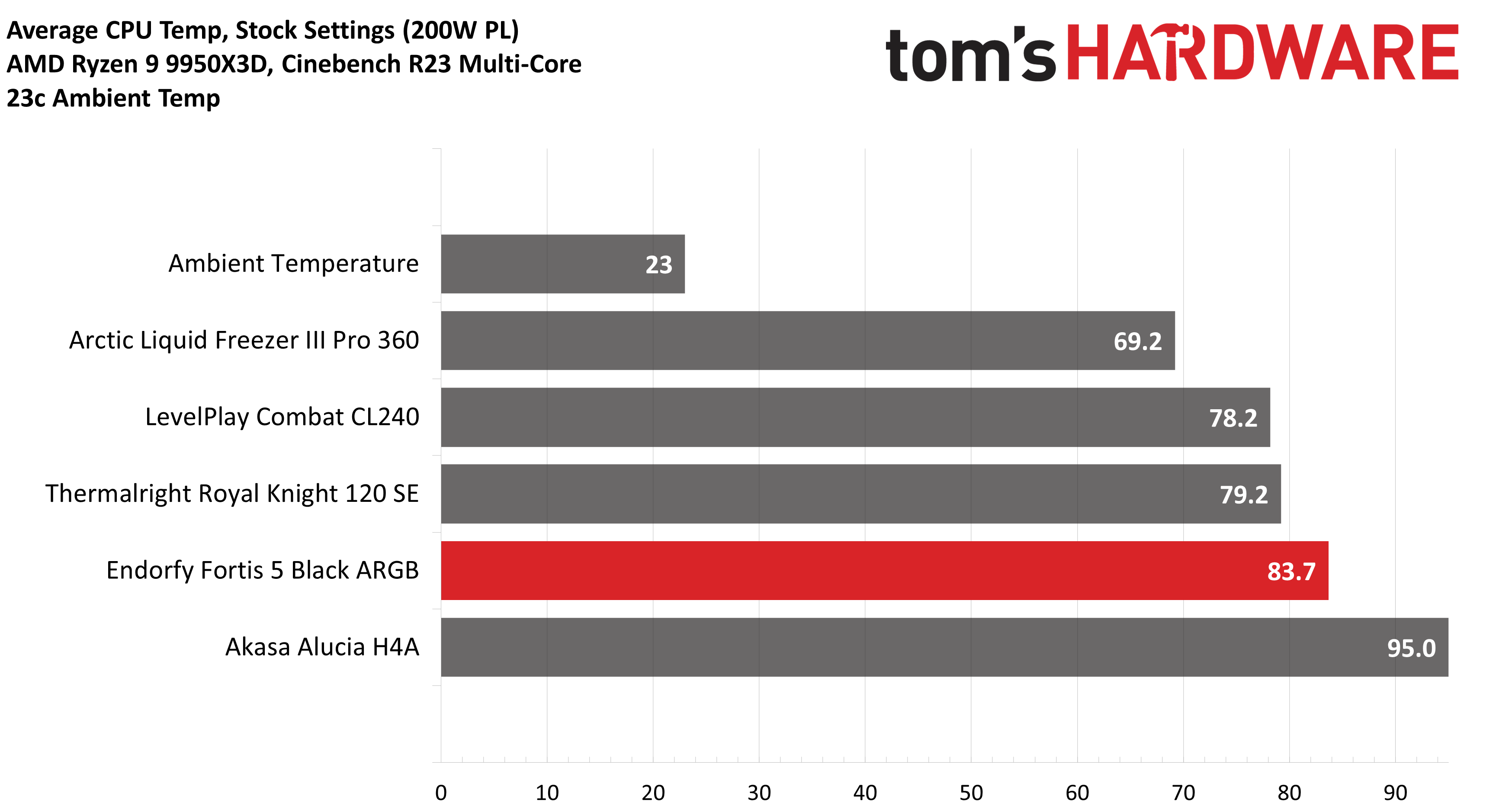
Going by temperature data alone, the results aren’t very impressive here. The CPU reaches a toasty 83.7 degrees. But that really doesn’t matter, because it keeps the CPU under its peak temperature and does so while running very quietly, at or below the lowest measurement my noise meter can measure, at 36.4 dBA. This means the true measurement of noise level might actually be lower.
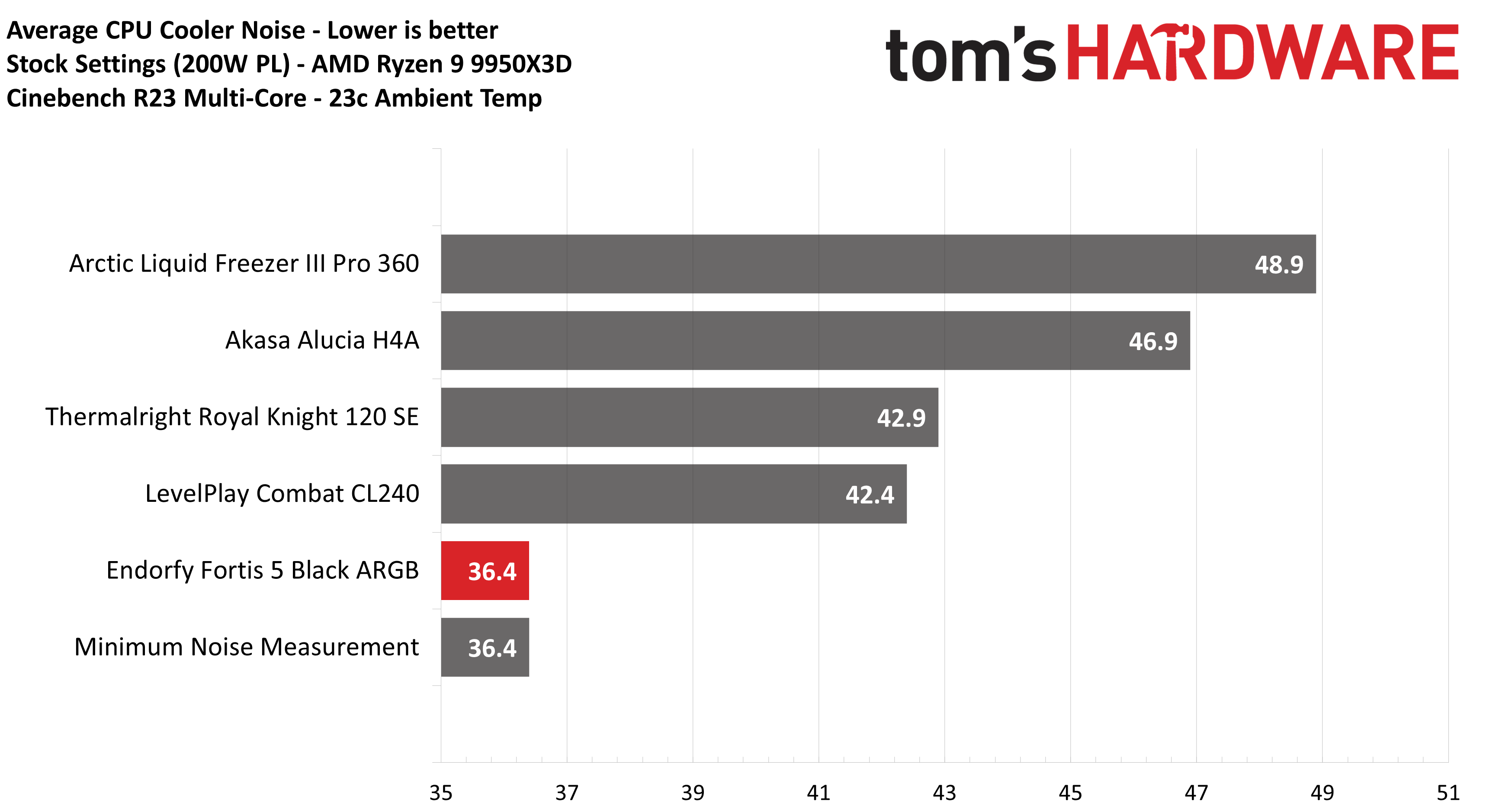
150W CPU + 290W GPU results
Testing a CPU Cooler in isolation is great for synthetic benchmarks, but doesn’t tell the whole story of how it will perform. If your GPU is running a full load, that heat doesn’t just disappear – it makes it harder for your CPU cooler to do its job due to the increased heat within your computer case.
The CPU power limit of 150W was chosen based on the worst CPU power consumption I’ve seen reported in gaming with AMD’s Ryzen 9 9950X3D. In my personal experience, most games use much lower power, but this might be biased by the games I play.
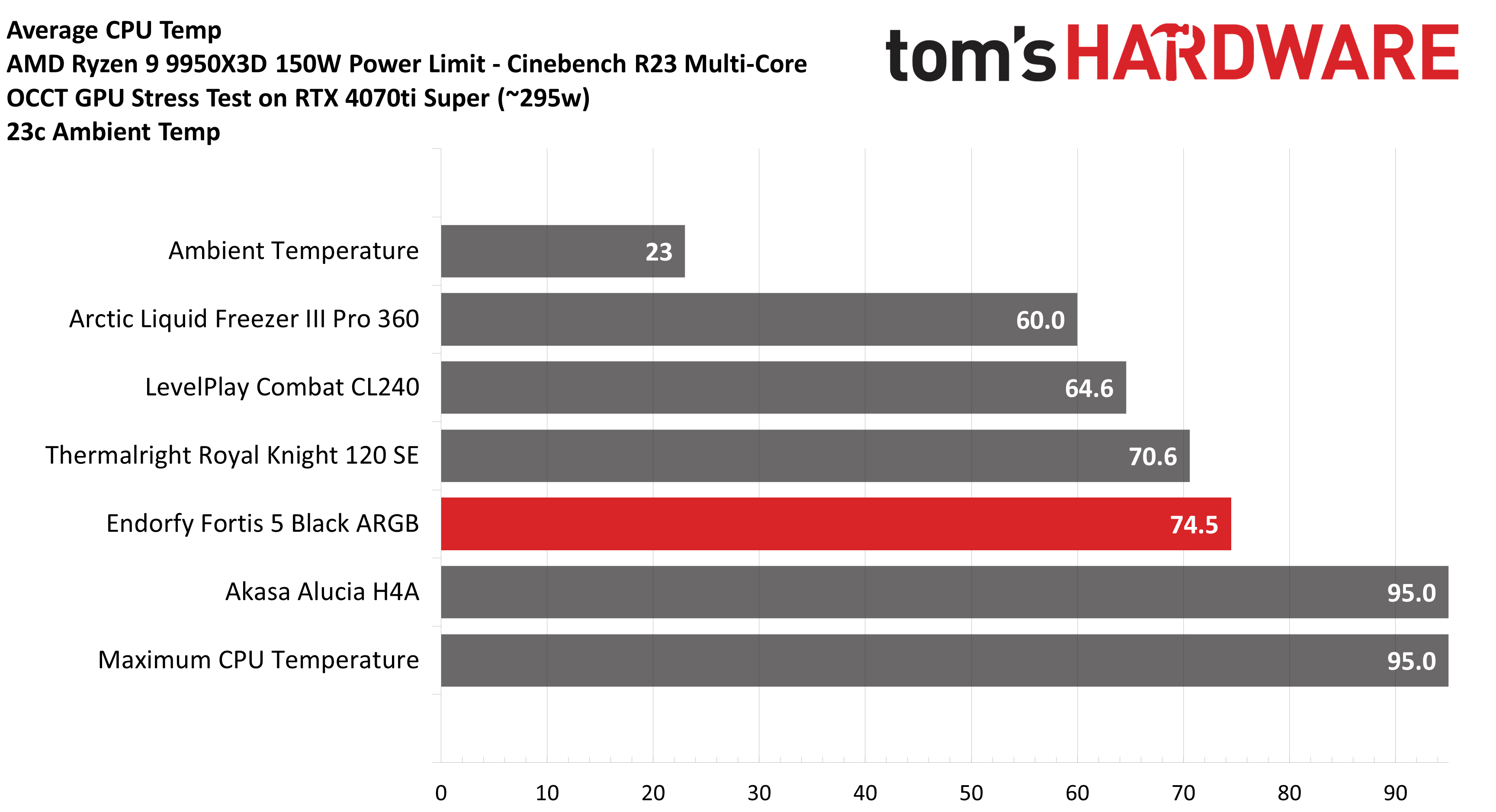
Again, looking at thermal performance alone would give you the incorrect assumption that this cooler is not impressive. The important thing is that the CPU is operating well under its peak temperature, and the cooler is running whisper quiet – 36.4 dBA!
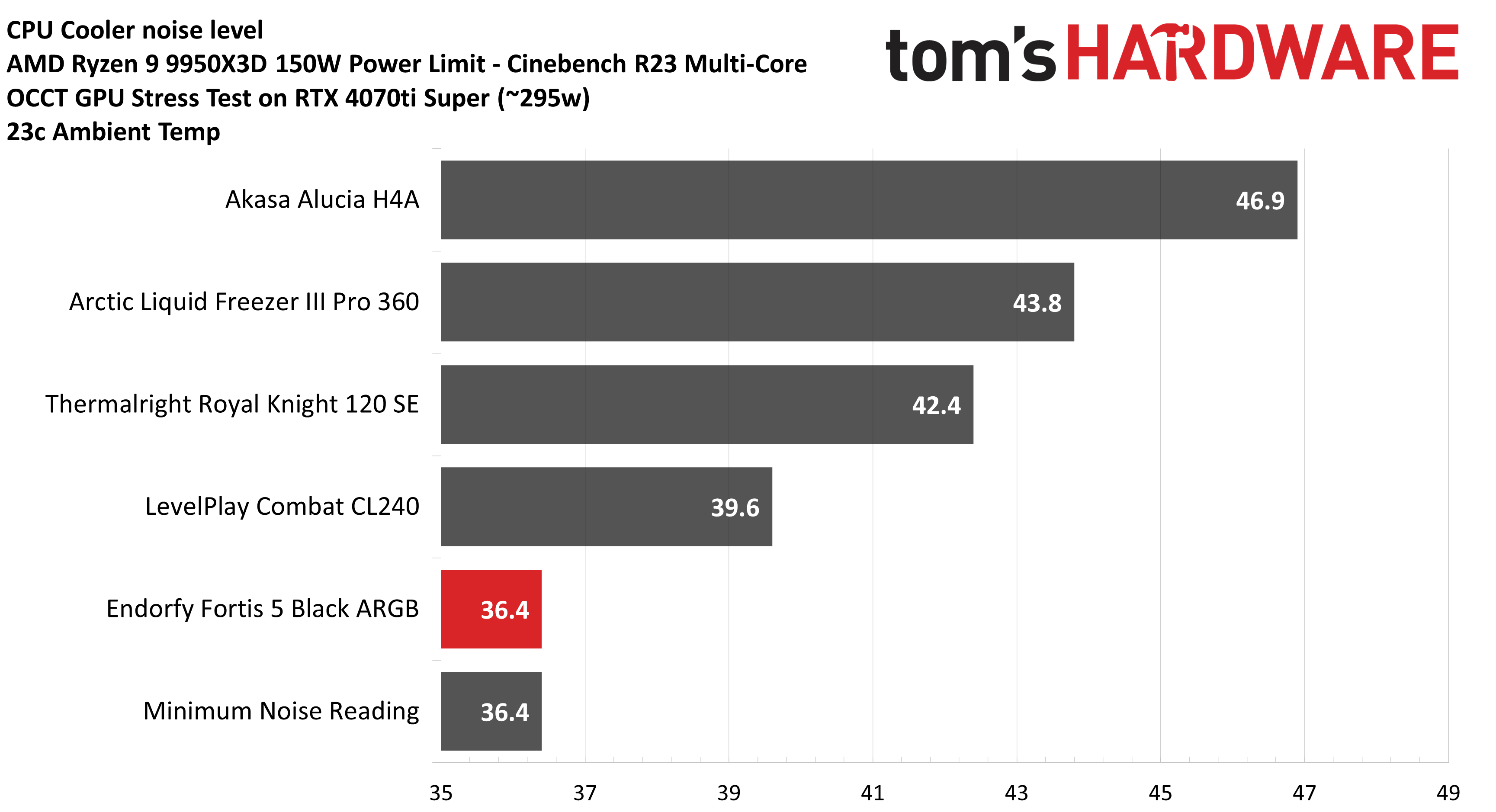
140W CPU results

The last round of test results we’ll look at in today’s review is a test with a 140W power limit imposed. This level of power is much easier for most CPU coolers to handle. But I’ve recorded lower power results for comparisons with SFF and air coolers for future reviews.

As with previous results, Endorfy’s Fortis 5 keeps the CPU within reasonable thermal values while running whisper quiet.
Conclusion
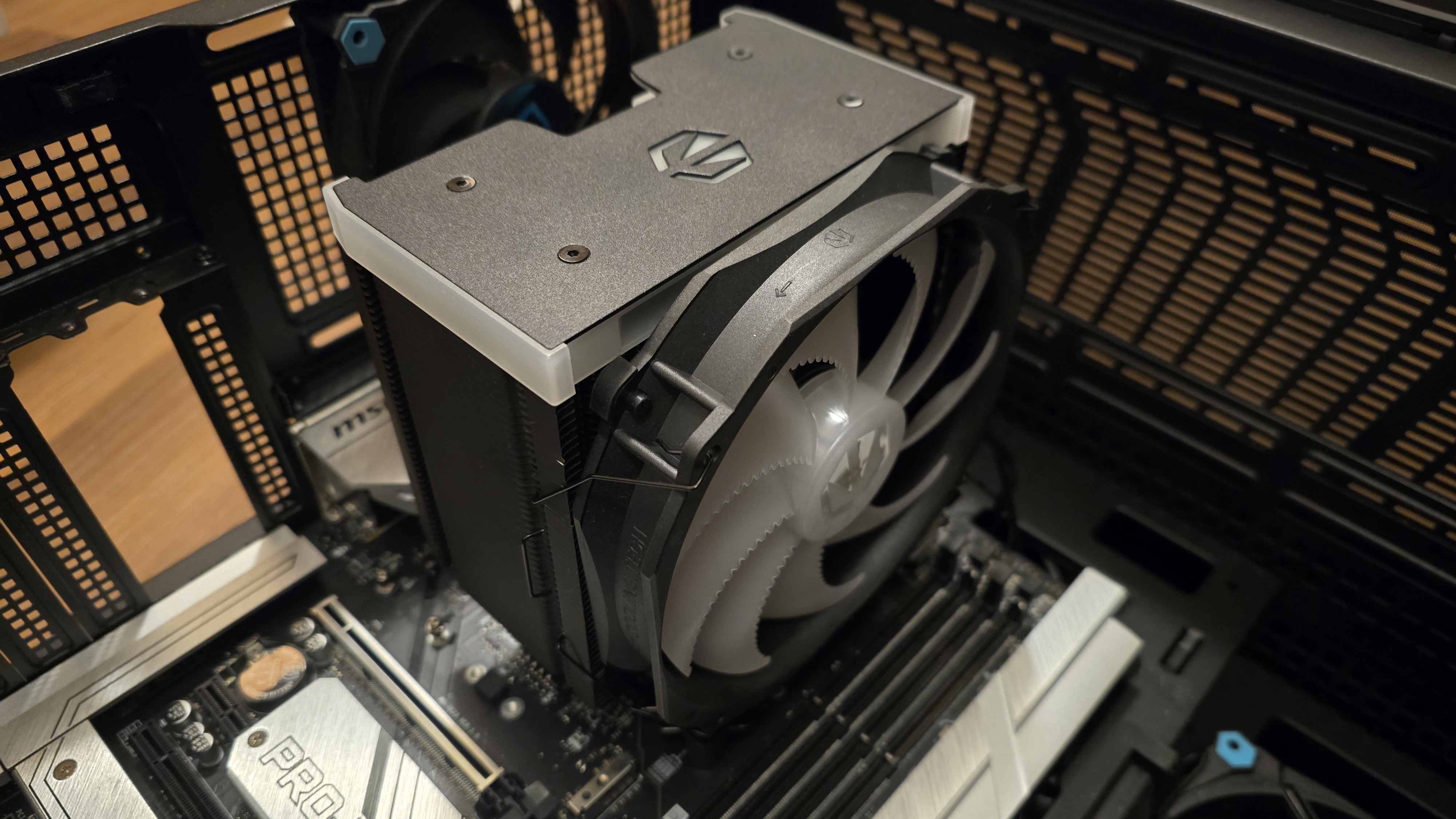
Endorfy’s Fortis 5 ARGB is a single tower air cooler with whisper-quiet noise levels, intended for users who value silent operation over maximum thermal performance. It’s powerful enough to handle AMD’s Ryzen 9 9950X3D at stock settings, handling 219W when power limits were removed. However, the performance on Intel CPUs was not as impressive. If you’re looking to compete in overclocking competitions or running a previous-generation Core i9, you might want to pass on this one. But for everyone else, this is the level of cooling I’d recommend for AMD’s Ryzen 9 9950X3D, so anything lesser should also run below thermal thresholds and extremely quiet with this cooler.

Albert Thomas is a contributor for Tom’s Hardware, primarily covering CPU cooling reviews.
-
Mindstab Thrull Glad to see AMD finally added into the testing, considering how strong a platform they have for gamers and beyond.Reply
But I've never heard of Endorfy. Who are they? Are they known in other areas (like Tyan) and just not consumer PC cooling? -
Reply
Albert.Thomas But I've never heard of Endorfy. Who are they? Are they known in other areas (like Tyan) and just not consumer PC cooling?TBH, I don't know much about them. I only first encountered them last year, and originally I didn't find their products impressive - but they seem to be improving their lineup rather well!
Thanks. I felt like the 9950X3D would be perfect for these type of reviews. Today's review was published out of order, you might be interested in the Liquid Freezer III Pro review which has more comparison results!Mindstab Thrull said:Glad to see AMD finally added into the testing, considering how strong a platform they have for gamers and beyond.
https://promohunters.info/pc-components/liquid-cooling/arctic-liquid-freezer-iii-pro-review%3Cblockquote%3E%3Cdiv class="author">Mindstab Thrull said:
I've got their Navis F360 ARGB AIO on hand, if Tom's Hardware will take it I'll test it soon and submit it for review.
https://www.techpowerup.com/299617/announcing-endorfy-a-new-european-brand-on-the-international-technology-stageMindstab Thrull said:But I've never heard of Endorfy. Who are they? Are they known in other areas (like Tyan) and just not consumer PC cooling?
I have an old Cooler Master with 5 direct-touch heat pipes (Geminii M5) that's still waiting for just the right project. Weirdly, I had to import it, because it apparently was never sold in the USA. I had previously bought its little brother, the M4 (which I think was sold here), but never used it due to discovering the sad fact of its sub-par performance. The M5 had not only one more heat pipe, but also "continuous direct touch technology", like what we see in the heatsink reviewed here. The few benchmarks I can find of it still aren't amazing, but I wonder how much of that is due to its low-profile fan.
IMO, we probably don't need a full set of results, but just like a shoot-out between some of the top-performing heatsinks. Probably doesn't make as much sense for less expensive "value" heatsinks, since most folks buying those models (unless they're also top performers) probably don't want to spend yet more money on a fan swap.
This is an interesting idea, but I'm not sure there would be enough user interest to justify a rate increase to management - and I'm already doing more testing than before. Some of the tests I'm doing haven't yet been published on the reviews you've seen with AMD's Ryzen 9950X3D, because they will only be relevant when looking at specific products.bit_user said:On an unrelated note... @Albert.Thomas , what do you think about doing some noise-normalize tests with the same model fan, on all heatsinks? This should be fairly revealing, as it should tell us more about how the heatsinks, themselves differ.
However, no matter what the MTBF on the fan, once it fails, it hits hard, which is why I've switched to dual fan designs, not for the extra cooling capacity, but the resilience.
Not that I've really ever had a CPU fan fail outright in decades, only one choking on surprisingly little dust (easily rectified) and another announcing it's failure well in advance with ball bearing noises. The former shut down the home firewall and at that time I spent every second week in France with five remaining home users rather dependent on Internet access... I counted myself rather lucky I was home that week!
When a CPU cooler fan fails, it's never convenient, and waiting for a replacement part pretty near inacceptable. So paying a little extra for that peace of mind seems like a bargain.
I do ECC and RAIDs for the same reason, but those tend to cost quite a bit extra.
As long as you're around, to fix it, I don't really see why you need that amount of redundancy. I'd be surprised if you didn't have plenty of spare fans lying around. I do, but then I'm often swapping out the fans that come with my cases & CPU coolers for aftermarket ones. Even if the temporary replacement fan you use doesn't move as much air or is a bit louder, it's probably adequate until a proper replacement can arrive.abufrejoval said:When a CPU cooler fan fails, it's never convenient, and waiting for a replacement part pretty near inacceptable. So paying a little extra for that peace of mind seems like a bargain.
I do those things to avoid silent data corruption, which can be insidious and infect even many of your backups, before you ever notice. For me, they aren't about uptime.abufrejoval said:I do ECC and RAIDs for the same reason, but those tend to cost quite a bit extra.
